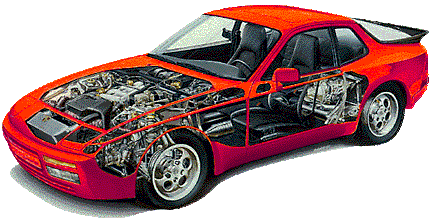

 This is a very easy task for the do-it-yourselfer and it saved me big coin. But as usual,
you need the proper tools: Drain pan (no more than 4.6" in height), oil filter wrench, 15mm
socket wrench and anti-sieze grease. There are several kinds of filter wrenches you can use here.
One is a claw type that basically digs into the filter. This is good for removing the
oil filter; however, I do not recommend it for installation. There is a socket type which
fits quite nicely on the top of the oil filter. This is ideal for installation. I would
strongly recommend you use a replacement filter with a one way valve:
Malhe (part # OC 142 ) works best.
This is a very easy task for the do-it-yourselfer and it saved me big coin. But as usual,
you need the proper tools: Drain pan (no more than 4.6" in height), oil filter wrench, 15mm
socket wrench and anti-sieze grease. There are several kinds of filter wrenches you can use here.
One is a claw type that basically digs into the filter. This is good for removing the
oil filter; however, I do not recommend it for installation. There is a socket type which
fits quite nicely on the top of the oil filter. This is ideal for installation. I would
strongly recommend you use a replacement filter with a one way valve:
Malhe (part # OC 142 ) works best.
Changing your own oil is probably the most inexpensive procedure
you can do yourself. The oil drain plug is located just behind the engine skid plate on the passenger
side (North American) and can be accessed quite easily without lifting the vehicle off the ground.
I've done this procedure many times and can assure you that the removal of the oil filter and drain
plug was difficult when I did it initially; but it became much easier the next time.
It was also a good idea to change the oil soon after I'd finished driving because the
hot oil would remove more sludge and sediment. But I had to be careful not to burn myself on any
of the car parts or the oil. An old set of oven mitts worked great here.
I began by removing the drain plug. It is easily accessed by lying
down on the right side of the vehicle (driver's right). It was a bit of a reach to get the wrench
on the plug (My long arms were a definite asset). Too tight? Probably because the person who changed
my oil last reefed on it as if he were swinging from tree to tree. Way-to-go Tarzan! "Don't despair",
I said. Here's what I'll do. Spray a bit of penetrating oil around the plug and place the wrench on it
so that it's at an angle of 45 degrees (approximately) to the ground. Then use the trusty persuader
(a hammer) and lightly but firmly tap the plug loose.
On a few occasions lightly tapping at the drain plug didn't work. This
didn't happen on my car, but on a friend's 944. I had warned him about getting his oil changed at
some of these lube specialty shops. But for what ever reason, he chose not to heed my advice. So then
we must resort to jacking up the vehicle. You can use the jack supplied by Porsche to initially raise
the car, but it is important to add additional support by strategically placing a jack stand under the
frame just in case your jack gives way (see your owner's manual for placement). Once all this has been
done you can remove the plug.
Once the plug was loosened, I then placed the drain pan underneath it
and removed the plug. I had to be careful because the oil was hot. Once the oil had drained I reinstalled
the plug using the same washer (there should be a washer between the plug and the oil pan ). However, before reinstalling the plug, I cleaned the plug and washer with a rag and put some anti-sieze grease on the washer
(this so it is easier to remove the next time and creates a better seal). You can torque the plug to speck
but I have found that a quarter turn past finger tight works just as well.
Now I move the drain pan under the oil filter and remove the spark plug wire
from the distributor cap in order to access the oil filter. A good socket filter wrench worked well here.
If Tarzan has struck again then my life has just become a bit more morose. There are a few options
open to me. I have found that a good filter wrench placed at the bottom of the filter will give me
better leverage for removing the most stubborn of oil filters. I'd try and stay away from gripping the filter
from the top because there is not much strength or rigidity for leverage and it could crush the filter.
And then I've gone from bad to "Oh F$%**"!
After cleaning the area were the filter sits with a rag, I prepared the
new filter for placement by applying a thin film of oil on the rubber lip. I would recommend the
Mahle oil filter (part # OC 142) as the replacement filter. After finger tighten the filter in place,
I then used a filter socket wrench to further tighten a quarter turn. With a new filter, these cars take
5.5 to 6 liters of Oil. After filling, I'd start the car and let it run for a minute or so (keeping in
mind I'd still be checking for leaks while the vehicle was running). Then, with the engine switch off
for about a couple of minutes, I'd check the oil level. Sometimes I needed to add a bit more oil. A final
check for leaks, and then the open road.
 One of the most inexpensive and easily performed procedures that will keep your 944 in top shape.
Although other plugs have worked adequately, I have found that the Bosch Plugs work the best for
performance and longevity. Some of you may experience difficulty with the hood struts:
in other words, the hood won't stay up. A good fix that I have found for this a small set of
vice grips placed on the bottom half of the hood strut . Place it firmly on the strut but not
with so much squeeze that it crushes the strut. But not with too little squeeze either (if the
hood comes down on your noggin you'll be motivated to find the right amount of tension. So do
right the first time and save yourself the pain). Confucius say " measure twice, cut once"
One of the most inexpensive and easily performed procedures that will keep your 944 in top shape.
Although other plugs have worked adequately, I have found that the Bosch Plugs work the best for
performance and longevity. Some of you may experience difficulty with the hood struts:
in other words, the hood won't stay up. A good fix that I have found for this a small set of
vice grips placed on the bottom half of the hood strut . Place it firmly on the strut but not
with so much squeeze that it crushes the strut. But not with too little squeeze either (if the
hood comes down on your noggin you'll be motivated to find the right amount of tension. So do
right the first time and save yourself the pain). Confucius say " measure twice, cut once"
Now that I've "gotten it up" as it were, I can begin by removing
the plug wires from spark plugs. I would recommend the this be done when the engine is stone cold.
This is so as to prevent damaging the threads on the engine block. Removing a hot plug from a
hot engine can be done; however, inserting a cold plug in a hot or warm engine can be disastrous.
Some of the most competent mechanics will not do it because changes in temperature can cause minute
but significant metal expansion and contraction. This means that the threads on the block may be out
just enough and the metal fatigued enough from the heat to start a different thread with a new cold plug
So with the engine cold, I begin by removing the plug wires from the
spark plugs. I did this by grabbing the boot from the 90 degree angle bend and pulling firmly. Do not pull
from the actual wire because you may damage it. I remove one wire and plug at a time so as not to become
confused. After you having removed the wire, I place the spark plug wrench with the ratchet so that
the wrench firmly sits on the block. I now begin to remove the plug.
Before inserting the New plugs I check the gap and put a little
bit of anti-seize grease on the threads of the plug for easy insertion (and removal for next time).
Before I reinsert the plug want to clean the threads on the engine block. I do this by using a long q-tip.
I reinsert the new plug by threading it by hand initially and then by ratchet. Torque to spec.
Repeat this procedure for the other three plugs.
This is another delicate procedure, but again very necessary.
Depending on the quality of fuel (Sunoco 94 or other racing fuel if you have access
and can afford to splurge) used, 60,000 km is about the right interval. A week before attempting
to remove the filter it would be a good idea to get underneath there and spray a penetrating oil
on the connecting bolts to ensure they come off easily (or they may not come off at all) in which
case it will cost you about a G note or more to get the fuel line replaced. Trust me on this one,
it is we worth the time and effort in this case to spray the connecting bolts a few times before
actually removing the fuel filter.
The fuel filter is located behind the right rear wheel and can
be easily accessed by removing the wheel. Spray penetrating oil on the connecting bolts to lubricate
them. You may want to repeat this procedure two or three times before you attempt to remove the fuel filter.
believe me, if those bolts break then it is no easy (or inexpensive ) task to replace the fuel line.
It will be about $1000.00 and you won't be able to sit down for a week.
Haynes has a complete procedure on this in there
Do-It-Yourself manual. I could go over the proceedure, but it is essentially the same as what is in their
manual. Go to your local library and check it out for yourself.
Very easy and inexpensive, but you will need a long flathead screwdriver and the proper allen key for the rotor. Bosch parts are recommended here. My proceedure for
this endeavour is identical to what is found in the Haynes automotive repair manual. Why repeat it here?
This was an item that I let my mechanic do.
I suppose I could have attempted it myself since there were so
many do-it-yourself manuals on the subject. However, This one I left to the expert.
Thanks Franz!

Back to main page